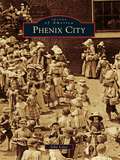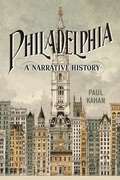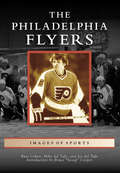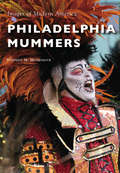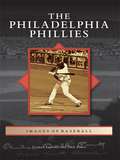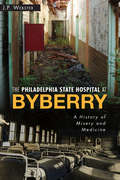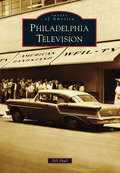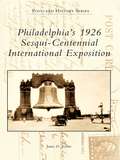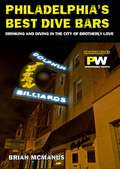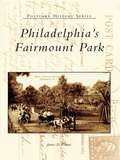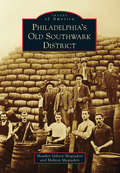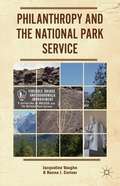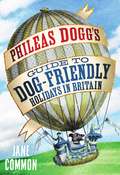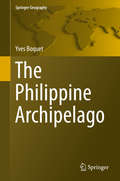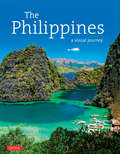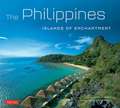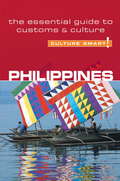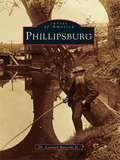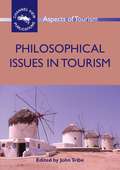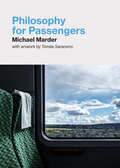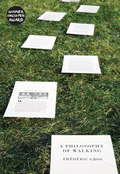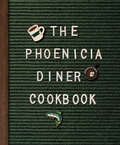- Table View
- List View
Phenix City (Images of America)
by John LylesPhenix City, Alabama, on the western bank of the Chattahoochee River across from Columbus, Georgia, was officially incorporated as Brownville in 1883. However, its history can be traced through Girard, Knights Station, Summerville, Fort Mitchell, the Creek Indian town of Coweta, and several other communities within Russell County. Phenix City has provided a setting for many of the important events in Alabama's history from early Spanish explorers, to its rich Native American heritage, to its role in opening and settling the Southern frontier, to its adherence to King Cotton, to its rebirth after being regarded the "wickedest city in America." Phenix City has undergone profound change and yet has retained its rural charm.
Philadelphia: A Narrative History
by Paul KahanA comprehensive history of Philadelphia from the region’s original Lenape inhabitants to the myriad of residents in the twenty-first centuryPhiladelphia is famous for its colonial and revolutionary buildings and artifacts, which draw tourists from far and wide to gain a better understanding of the nation’s founding. Philadelphians, too, value these same buildings and artifacts for the stories they tell about their city. But Philadelphia existed long before the Liberty Bell was first rung, and its history extends well beyond the American Revolution.In Philadelphia: A Narrative History, Paul Kahan presents a comprehensive portrait of the city, from the region’s original Lenape inhabitants to the myriad of residents in the twenty-first century.As any history of Philadelphia should, this book chronicles the people and places that make the city unique: from Independence Hall to Eastern State Penitentiary, Benjamin Franklin and Betsy Ross to Cecil B. Moore and Cherelle Parker. Kahan also shows us how Philadelphia has always been defined by ethnic, religious, and racial diversity—from the seventeenth century, when Dutch, Swedes, and Lenapes lived side by side along the Delaware; to the nineteenth century, when the city was home to a vibrant community of free Black and formerly enslaved people; to the twentieth century, when it attracted immigrants from around the world. This diversity, however, often resulted in conflict, especially over access to public spaces. Those two themes— diversity and conflict— have shaped Philadelphia’s development and remain visible in the city’s culture, society, and even its geography. Understanding Philadelphia’s past, Kahan says, is key to envisioning future possibilities for the City of Brotherly Love.
Philadelphia Flyers, The (Images of Sports)
by Joe Del Tufo Bruce Scoop" Cooper Russ Cohen Mike Del TufoThe Philadelphia Flyers joined the National Hockey League (NHL) in 1967, along with five other teams, to double the league from six to twelve teams. They have enjoyed a lot of success since, including being the first expansion team to win the Stanley Cup. They won back-to-back cups in 1973-1974 and 1974-1975 and would qualify for the Stanley Cup Final six more times. The Flyboys have left their mark on the NHL through their physicality, which helped them garner the nickname "Broad Street Bullies." This book is a pictorial history of the Flyers that examines their modern history and looks back at their legend.
Philadelphia Mummers (Images of Modern America)
by Stephen M. HighsmithThe Philadelphia Mummers are costumed individuals and families who celebrate by “strutting” and performing on New Year’s Day. For many, mummery is also a way of life. The first official parade occurred in 1901, but it is an evolving tradition, reflecting both the challenges and opportunities of changing times. Philadelphia Mummers tells the story of modern-day mummery and the expressions of art, freedom, and celebration of thousands of people who come together in the working-class spirit of America’s oldest annual folk parade.
Philadelphia Phillies, The (Images of Baseball)
by Seamus Kearney Dick RosenThe Philadelphia Phillies, one of the oldest teams in Major League Baseball, have maintained a strong, loyal fan base for over 125 years. Despite historic set backs, the franchise has proven resilient and evolved into a perennial contender with consistently large attendance figures. In fact, the Phillies claim 37 Hall of Famers, two World Series championships, seven National League pennants, and nine division titles. The Philadelphia Phillies chronicles the greatness of Grover Cleveland Alexander, the remarkable career of Richie Ashburn, the perfection of Jim Bunning, and the teams of success and luster as well as those shining stars of the less successful eras.
The Philadelphia State Hospital at Byberry: A History of Misery and Medicine (Landmarks Ser.)
by John Paul WebsterThis account of the infamous asylum is “an excellent record of greed and corruption, but it is also a powerful testimonial to compassion and kindness” (Hidden City).The Quaker City and its hospitals were pioneers in the field of mental health. Yet by the end of the nineteenth century, its institutions were crowded and patients lived in shocking conditions. The mentally ill were quartered with the dangerously criminal. By 1906, the city had purchased a vast acreage of farmland incorporated into the city, and the Philadelphia Hospital dubbed its new venture Byberry City Farms. From the start, its history was riddled with corruption and committees, investigations and inquests, appropriations and abuse. Yet it is also a story of reform and redemption, of heroes and human dignity—many dedicated staff members did their best to help patients whose mental illnesses were little understood and were stigmatized by society.“The closed hospital’s almost forgotten story intrigued him immediately and then became his passion . . . Webster tells the hospital’s 100-year story in a brisk, easy-to-read style, and the book is illustrated with 75 photographs from the Historical Society of Pennsylvania, Temple University Urban Archives, the Pennsylvania State Archives, the Athenaeum of Philadelphia, PhillyHistory.org and friends.” —Northeast Times“Webster . . . wrote his book because of his fascination with an abandoned building he discovered in 2002. He wanted to tell the story of Byberry, one he believes many people do not fully understand.” —Philadelphia Neighborhoods
Philadelphia Television
by Bill ShullThe history of Philadelphia television is the history of television in America. Philo Farnsworth, credited with inventing television, performed some of his earliest experiments at the Franklin Institute and at 1230 Mermaid Lane. Those experiments led to the city's first television station, W3XE. Channel 3 was also the first local station in the country to broadcast in color. WCAU-TV Channel 10 constructed the first building in the world designed specifically as a television station. WFIL created one of the most iconic shows in television history, American Bandstand, as well as Action News, which has helped Channel 6 stay on top of the ratings for most of the last 40 years. Dick Clark, Ed McMahon, Ernie Kovacs, Tom Snyder, David Brenner, Maury Povich, Kelly Ripa, Brian Williams, and others are among those who have worked in Philadelphia television throughout its history.
Philadelphia's 1926 Sesqui-Centennial International Exposition
by James D. RistineIn 1926, the city of Philadelphia hosted the Sesqui-Centennial International Exposition to honor the 150th anniversary of American independence. The exposition featured four major exhibition palaces where innovations and advancements in science, technology, education, industry, and agriculture were displayed. An additional fifth palace was dedicated to the fine arts, and foreign nations and individual states erected their own buildings as well. The exposition's theme of patriotism was showcased through the re?created High Street of 1776, a favorite for many. Visitors were also entertained and delighted as they experienced areas known as Treasure Island and the Gladway, where all manner of amusements abounded. Crowds were drawn to the many sporting and cultural events held in the newly built stadium. Even the grounds of the navy yard were opened to the public, allowing citizens views of historic and modern naval vessels and military exhibits. By these offerings, and many others, the Sesqui-Centennial International Exposition celebrated the nation's past, present, and future.
Philadelphia's Best Dive Bars
by Brian McmanusPhiladelphia's Best Dive Bars reviews the grittiest drinking establishments in the city of brotherly love. If you want to avoid the tourist traps listed in those other bar guides and find out where to get wasted after visiting the Liberty Bell, then this book is required reading.Brian McManus is the music editor and a contributing food writer at Philadelphia Weekly. He's written for Houston Press, San Francisco Weekly, Chicago Reader, Cleveland Scene, and Spin magazine.
Philadelphia's Fairmount Park
by James D. RistinePhiladelphia's Fairmount Park focuses on the more than four thousand acres of land along the east and west banks of the Schuylkill River and into parts of the Wissahickon Valley that comprise one of the world's largest urban parks. Historically and architecturally important structures and buildings are chronicled, such as the famous waterworks, the many bridges that span the park's waterways, the Zoological Gardens, and Boathouse Row. Numerous fountains, monuments, and artistic sculptures that dot the landscape are also documented. Rich in natural beauty, the park's meadows, gardens, lush vegetation, rugged ravines, and wooded areas will capture the eye. Philadelphia's Fairmount Park is a nostalgic view of the park as it was enjoyed by visitors during the first quarter of the twentieth century.
Philadelphia's Old Southwark District (Images of America)
by Heather Gibson Moqtaderi Mehron MoqtaderiThe area along the banks of the Delaware River originally known as Philadelphia's Southwark District encompasses the present-day neighborhoods of Queen Village, Pennsport, and Dickinson Square West. Southwark's deep history is tied to its relationship to the waterfront and the multitude of immigrant communities that settled its streets. The Washington Avenue Immigration Station, Southwark's counterpart to Ellis Island, was a testament to the waves of immigrants reaching America's shores in the 19th and early 20th centuries. Many of the immigrants who stayed in Philadelphia found inexpensive housing in Southwark and employment along the waterfront. Today, the neighborhoods of old Southwark continue to embrace diversity. Many of the area's historic houses still stand alongside newly built homes. While the construction of high-volume roadways cut off the neighborhoods from the waterfront, new efforts are reconnecting Southwark to the river through improved access points and attractive waterfront recreation areas.
Philanthropy And The National Park Service
by Jacqueline Vaughn Hanna J. CortnerAs the National Park Service prepares for its centennial in 2016, this book provides an in-depth analysis of the role of philanthropy in national parks, with a focus on non-profit organizations known as friends groups and cooperating associations. Providing a historical review of partnerships through the lifetime of the NPS, up to a contemporary analysis of the legal and organizational framework under which non-profit philanthropic partners operate, Jacqueline Vaughn and Hanna J. Cortner explore the challenges the National Park Service faces in dealing with non-profit partners. Based on personal interviews with more than 50 non-profit leaders and National Park Service staff, financial data, and comprehensive site visits, Vaughn and Cortner offer a unique and informative view of the landscape in which philanthropy groups succeed - and sometimes fail.
Phileas Dogg's Guide to Dog Friendly Holidays in Britain
by Jane CommonA canine guide to British holidays, seeking out the best dog-friendly days out, beaches, hotels, pubs, campsites, cottages and holidays. An amusing and informative guide, illustrated with photos of different dogs, from pedigrees to mutts, at various locations around Britain. The book builds on the success of the website www.phileasdogg.com, which has been running for 18 months and has a mailing list and social media following in the thousands. The site's main canine correspondent is Attlee, aka Phileas Dogg, a three year old Battersea mongrel, owned by freelance journalist Jane Common. As well as Attlee, the site is written by a team of Rover Reporters from as far afield as the Shetland Isles and Cornwall. In the short time it's been running, the site has been picked up by The Evening Standard and The Guardian - "even if you don't have a dog we urge you to read this"; Waitrose Weekend, Prima, Real People and Dogs Today magazines as well as generating local paper stories around the country, in places where Phileas has visited. Jane has been invited on to BBC Radio as an expert in dog travel and worked with Visit England, the Kennel Club and Battersea Dogs and Cats Home to promote dog-friendly holidays and days out.
Phileas Dogg's Guide to Dog Friendly Holidays in Britain
by Jane CommonA canine guide to British holidays, seeking out the best dog-friendly days out, beaches, hotels, pubs, campsites, cottages and holidays. An amusing and informative guide, illustrated with photos of different dogs, from pedigrees to mutts, at various locations around Britain. The book builds on the success of the website www.phileasdogg.com, which has been running for 18 months and has a mailing list and social media following in the thousands. The site's main canine correspondent is Attlee, aka Phileas Dogg, a three year old Battersea mongrel, owned by freelance journalist Jane Common. As well as Attlee, the site is written by a team of Rover Reporters from as far afield as the Shetland Isles and Cornwall. In the short time it's been running, the site has been picked up by The Evening Standard and The Guardian - "even if you don't have a dog we urge you to read this"; Waitrose Weekend, Prima, Real People and Dogs Today magazines as well as generating local paper stories around the country, in places where Phileas has visited. Jane has been invited on to BBC Radio as an expert in dog travel and worked with Visit England, the Kennel Club and Battersea Dogs and Cats Home to promote dog-friendly holidays and days out.
The Philippine Archipelago
by Yves BoquetThis book presents an updated view of the Philippines, focusing on thematic issues rather than a description region by region. Topics include typhoons, population growth, economic difficulties, agrarian reform, migration as an economic strategy, the growth of Manila, the Muslim question in Mindanao, the South China Sea tensions with China and the challenges of risk, vulnerability and sustainable development.
The Philippines: A Visual Journey
by Elizabeth V. ReyesThis beautifully photographed travel pictorial captures the people, art, architecture, food and landscapes of the Philippines.The Philippine Archipelago with its 7,100 islands is culturally diverse and unique in Southeast Asia, and renowned for the splendor of its coastal beaches and terraced mountains. Seventy million Filipinos have been nurtured by both tropical environment and unique historical development-through 300 years of Spanish Chistianization and 40 years of American modernization-and have emerged as an attractive blend of East and West, soul and style. The island country is perhaps best known for the friendliness of its people and their natural sense of song, dance and hospitality. The archipelago is also called "Pearl of the Orient".With over 150 photographs and a detailed map, The Philippines: A Visual Journey is an essential book for expats or tourists traveling to the Philippines.
Philippines: Islands of Enchantment
by George Tapan Alfred A. YusonThe Philippines: Islands of Enchantment captures all the marvels and excitement found throughout the 7000-island archipelago. Beautiful photographs by award-winning photographer George Tapan are paired with rich text by author Alfred A. Yuson to make this new paperback edition a must for those that have traveled to this island paradise or just spend their days dreaming about going.The Philippines: Islands of Enchantment is a fascinating exploration of the islands and her people including:sun-blessed beaches and pristine rain forestscenturies-old churches and tribal ritualsdynamic cities and a wealth of ethic and environmental diversityyearlong fiestas celebrated by Filipinos and more!
Philippines: Islands of Enchantment
by Alfred A. Yuson George TapanThe Philippines: Islands of Enchantment captures all the marvels and excitement found throughout the 7000-island archipelago. Beautiful photographs by award-winning photographer George Tapan are paired with rich text by author Alfred A. Yuson to make this new paperback edition a must for those that have traveled to this island paradise or just spend their days dreaming about going.The Philippines: Islands of Enchantment is a fascinating exploration of the islands and her people including:sun-blessed beaches and pristine rain forestscenturies-old churches and tribal ritualsdynamic cities and a wealth of ethic and environmental diversityyearlong fiestas celebrated by Filipinos and more!
Philippines - Culture Smart!
by Graham Collins-JonesCulture Smart! provides essential information on attitudes, beliefs and behavior in different countries, ensuring that you arrive at your destination aware of basic manners, common courtesies, and sensitive issues. These concise guides tell you what to expect, how to behave, and how to establish a rapport with your hosts. This inside knowledge will enable you to steer clear of embarrassing gaffes and mistakes, feel confident in unfamiliar situations, and develop trust, friendships, and successful business relationships.Culture Smart! offers illuminating insights into the culture and society of a particular country. It will help you to turn your visit-whether on business or for pleasure-into a memorable and enriching experience. Contents include* customs, values, and traditions* historical, religious, and political background* life at home* leisure, social, and cultural life* eating and drinking* do's, don'ts, and taboos* business practices* communication, spoken and unspoken"Culture Smart has come to the rescue of hapless travellers." Sunday Times Travel"... the perfect introduction to the weird, wonderful and downright odd quirks and customs of various countries." Global Travel"...full of fascinating-as well as common-sense-tips to help you avoid embarrassing faux pas." Observer"...as useful as they are entertaining." Easyjet Magazine"...offer glimpses into the psyche of a faraway world." New York Times
The Philistines and Aegean Migration at the End of the Late Bronze Age
by Assaf Yasur-LandauAssaf Yasur-Landau examines the early history of the biblical Philistines who were among the 'Sea Peoples' who migrated from the Aegean area to the Levant during the early twelfth century BC. Creating an archaeological narrative of the migration of the Philistines, he combines an innovative theoretical framework on the archaeology of migration with new data from excavations in Greece, Turkey, Cyprus, Syria, Lebanon, and Israel and thereby reconstructs the social history of the Aegean migration to the southern Levant. The author follows the story of the migrants from the conditions that caused the Philistines to leave their Aegean homes, to their movement eastward along the sea and land routes, to their formation of a migrant society in Philistia and their interaction with local populations in the Levant. Based on the most up-to-date evidence, this book offers a new and fresh understanding of the arrival of the Philistines in the Levant.
Phillipsburg
by Dr Leonard Buscemi Sr.The largest town in Warren County, Phillipsburg is located in the southwestern tip of the county along the Delaware River. Although the origin of its name is uncertain-named after a Native American chief or an early landowner-the area was known as Phillipsburg as early as 1749 and was officially incorporated in 1861. Situated relatively close to New York and Philadelphia, Phillipsburg developed as a manufacturing hub. Companies such as J.R. Templin's Iron and Brass Foundry, Cooper Iron Works, and Reese & Company helped Phillipsburg to grow. The prosperity alive in the town during these times is evident on the faces of those pictured in Phillipsburg. In these rare photographs, our earlier neighbors are on the field playing for the company team, on leisurely drives, or hard at work building the old trolley line. Even when times were harder, such as during flooding of the Delaware River, history was recorded with images and is retold in this volume.
Philosophical Issues in Tourism
by John TribeDespite the geometric expansion of tourism knowledge, some areas have remained stubbornly underdeveloped and a full or comprehensive consideration of the philosophical issues of tourism represents one such significant knowledge gap. A key aim of this book therefore is to provide an initial mapping of, and fresh insights into this territory. In doing so it discusses key philosophical questions in the field such as What is tourism? Who is a tourist? What is wisdom? What is it to know something? What is the nature of reality? Why are some destinations considered beautiful? Why is tourism desirable? What is good and bad tourism? What are desirable ends? These and similar topics are addressed this book under the headings of truth, beauty and virtue.
Philosophy for Passengers
by Michael MarderA philosophical guide to passengerhood, with reflections on time, space, existence, boredom, our sense of self, and our sense of the senses.While there are entire bookstore sections—and even entire bookstores—devoted to travel, there have been few books on the universal experience of being a passenger. With this book, philosopher Michael Marder fills the gap, offering a philosophical guide to passengerhood. He takes readers from ticketing and preboarding (preface and introduction) through a series of stops and detours (reflections on topics including time, space, existence, boredom, our sense of self, and our sense of the senses) to destination and disembarking (conclusion). Marder finds that the experience of passengers in the twenty-first century is experience itself, stretching well beyond railroad tracks and airplane flight patterns. On his journey through passengerhood, he considers, among many other things, passenger togetherness, which goes hand in hand with passenger loneliness; flyover country and the idea of placeness; and Descartes in an airplane seat. He tells us that the word metaphor means transport in Greek and discusses the gray area between literalness and metaphoricity; explains the connection between reading and riding; and ponders the difference between destination and destiny. Finally, a Beckettian disembarking: you might not be able to disembark, yet you must disembark. After the voyage in the world ends, the journey of understanding begins.
A Philosophy of Walking
by Clifford Harper Frederic Gros John Howe"It is only ideas gained from walking that have any worth." --Nietzsche In A Philosophy of Walking, a bestseller in France, leading thinker Frédéric Gros charts the many different ways we get from A to B - the pilgrimage, the promenade, the protest march, the nature ramble - and reveals what they say about us. Gros draws attention to other thinkers who also saw walking as something central to their practice. On his travels he ponders Thoreau's eager seclusion in Walden Woods; the reason Rimbaud walked in a fury, while Nerval rambled to cure his melancholy. He shows us how Rousseau walked in order to think, while Nietzsche wandered the mountainside to write. In contrast, Kant marched through his hometown every day, exactly at the same hour, to escape the compulsion of thought. Brilliant and erudite, A Philosophy of Walking is an entertaining and insightful manifesto for putting one foot in front of the other.From the Hardcover edition.
The Phoenicia Diner Cookbook: Dishes and Dispatches from the Catskill Mountains
by Mike Cioffi Chris Bradley Sara B. Franklin85 comfort food recipes, including classic Americana dishes and reimagined favorites, from the celebrated Phoenicia Diner in New York's idyllic Catskill mountainsWhether you're a local or just passing through, the revamped Phoenicia Diner is an irresistible must-stop in the region, beloved for its honest cooking that seamlessly combines the best of the classics (Classic Buttermilk Pancakes, Chicken with Chive-Buttermilk Dumplings) with the multifaceted way we love to eat today (Chile-Braised Lamb Tostadas, Cider-Braised Duck and Grits). In the Phoenicia Diner Cookbook, you'll find a roster of approachable, soulful dishes that are deeply delicious and full of life-satisfying abundance. "All Day Breakfast" recipes like a Twice-Baked Potato Skillet and gold standards with a twist, such as Roasted Chicken with Tarragon-Honey Glazed Carrots, are complemented by rich essays on the region's fascinating history and the revival that defines it today, creating an evocative love letter to both the area and disappearing diners everywhere.
